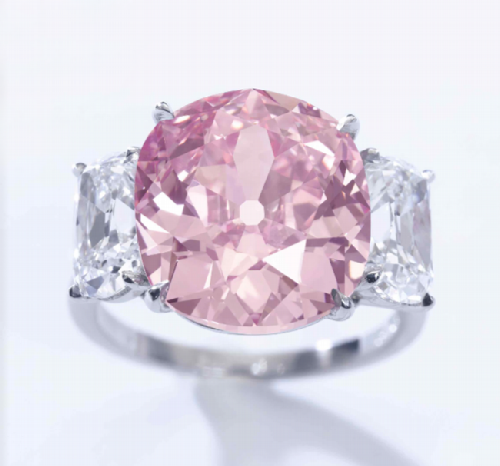
Hydrangea is one of the world’s most famous colored diamonds. It has a delicate pink-peach shade that makes it akin to the flower of the same name. Interestingly, the name of the stone has nothing to do with the plant: it was named after Hortenna de Boharn, Queen of Holland.
Hydrangea is also one of the largest pink diamonds ever found by man. Its weight is 20 carats. Pink diamonds of this size can literally be counted on one hand.

Origin
Hydrangea is a diamond of Indian origin. It was found in the middle of the 17th century in one of the famous Kollur mines, near Golconda. By that time, more than 60 thousand people were engaged in diamond mining in southern India: this region was the world’s main source of diamonds.
But even in the rich deposits of Golconda, pink diamonds were rare. Researchers believe that they accounted for no more than 1-2% of all mined stones. And yet, Golconda gave the world many amazing finds: Nur-Ul-Ain, Shah Yahan, Agra, Hortense and other magnificent stones.

Stone history
The Hortense diamond was named after Napoleon Bonaparte’s stepdaughter and Napoleon III’s mother, the Dutch queen Hortenna de Boharne. Interestingly, the queen never owned this stone, or even wore jewelry with it. The question of why the stone was named after her remains open to this day. The diamond was acquired by King Louis XIV.
In an inventory dated 1691, the stone is mentioned as part of the crown jewels, albeit under a different name. How the stone was purchased is unknown: the largest pink diamond sold to King Tavernier weighed just over 14 carats.
In 1792, during the French Revolution, the Hortense diamond was stolen. On the morning of September 17, police commissioners discovered that a robbery had been committed in the public treasury where the crown jewels were kept.

The thieves gained access to the building through the window by climbing up the pillar.
They broke down the doors to 11 offices where crown jewels and regalia were kept. The attackers were surprisingly accurate and quick in identifying the most valuable stones from the collection – so the police began to suspect if they had accomplices from the Treasury officers.
A year later, one of the robbers was caught: on pain of execution, he revealed the location of the treasures. It turned out that the crown jewels were hidden in the attic of an old house in one of the suburbs of Paris. The rest of the participants in the crime could not be found, but the main thing is that the loot was found intact. After the French Revolution, Hortense belonged to Eugenie, wife of Emperor Napoleon III. In 1830, the diamond was stolen again, but just as quickly returned.
During the Third Republic, in 1887, the French government decided to sell off most of the crown jewels. This was done in order to thwart any attempt to restore the monarchy in France. The hydrangea was not sold: an exception was made for it due to its high historical value. The stone is kept in the Louvre.

Characteristics
Hydrangea is a pale orange-pink diamond. It weighs 20 carats and has an unusual cut: a unique 5-sided crown shape and a matching pavilion. There is a serious defect in the stone in the form of a crack – a feather extending from the waist to the curtain. The cost of the diamond is not known for certain, since it was not put up for auction. It is only known that in 1791 it was valued at 48 thousand liveries.

